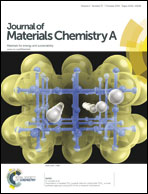Infrared-driving actuation based on bilayer graphene oxide-poly(N-isopropylacrylamide) nanocomposite hydrogels†
Abstract
Stimulus-responsive hydrogels are utilized as smart materials in actuators for transforming external stimuli into actuation movements. Infrared (IR) irradiation is considered to be an ideal driving energy because it can penetrate into biomaterials without direct contact and can be remotely controlled. In the present work, a new IR-driving bilayer hydrogel actuator is prepared by stacking a graphene oxide (GO)-hectorite clay-poly(N-isopropylacrylamide) (PNIPAm) gel layer onto a hectorite clay-PNIPAm gel layer, synthesized through stepwise in situ polymerization. GO in the gel absorbs the IR irradiation and rapidly and efficiently transforms it into thermal energy, resulting in a much faster temperature increase in the GO-containing gel layer than that of the gel layer without GO, and the temperature of the former becomes higher than that of the latter. This bilayer structure with different temperatures changes the isotropic volume contraction into an anisotropic deformation, i.e., bending, which is always toward the GO-containing layer. Moreover, this bending occurs in the atmosphere, owing to the self-supporting capability of the tough gels. The repetition of the bending recovery is realized by turning the IR light on and off. According to these observations, the bilayer gel with GO provides a tough and IR-driving material for new soft actuators.


 Please wait while we load your content...
Please wait while we load your content...